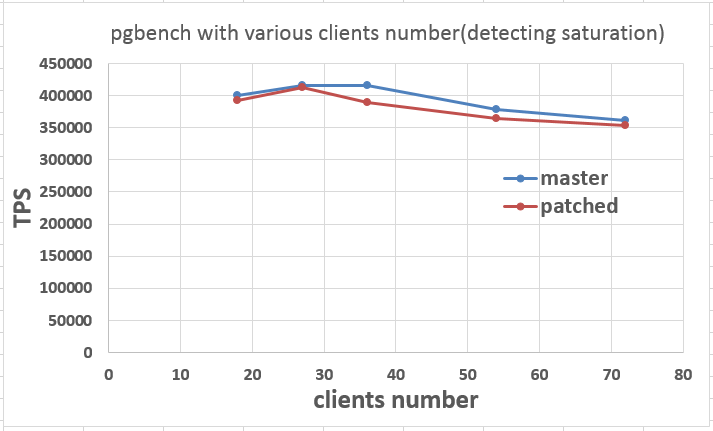RE: Locking B-tree leafs immediately in exclusive mode
| From: | "Imai, Yoshikazu" <imai(dot)yoshikazu(at)jp(dot)fujitsu(dot)com> |
|---|---|
| To: | 'Alexander Korotkov' <a(dot)korotkov(at)postgrespro(dot)ru> |
| Cc: | pgsql-hackers <pgsql-hackers(at)postgresql(dot)org> |
| Subject: | RE: Locking B-tree leafs immediately in exclusive mode |
| Date: | 2018-07-10 11:18:26 |
| Message-ID: | 0F97FA9ABBDBE54F91744A9B37151A51189451@g01jpexmbkw24 |
| Views: | Whole Thread | Raw Message | Download mbox | Resend email |
| Thread: | |
| Lists: | pgsql-hackers |
On Mon, July 9, 2018 at 4:44 PM, Alexander Korotkov wrote:
> > Firstly, I did performance tests on 72-cores machines(AWS c5.18xlarge) same as you did.
>
> OK. But not that c5.18xlarge is 72-VCPU machine, which AFAIK is
> close to the performance of 36 physical cores.
Thanks for pointing that. I referred to /proc/cpuinfo and understood there are 36 physical cores.
> In this case it also looks like we observed 1% regression. Despite 1%
> may seem to be very small, I think we should clarify whether it really
> exists. I have at least two hypothesis about this.
>
> 1) There is no real regression, observed difference of TPS is less
> than error of measurements. In order to check that we need to retry
> the experiment multiple times. Also, if you run benchmark on master
> before patched version (or vice versa) you should also try to swap the
> order to make sure there is no influence of the order of benchmarks.
> 2) If we consider relation between TPS and number of clients, TPS is
> typically growing with increasing number of clients until reach some
> saturation value. After the saturation value, there is some
> degradation of TPS. If patch makes some latency lower, that my cause
> saturation to happen earlier. In order to check that, we need run
> benchmarks with various number of clients and draw a graph: TPS
> depending on clients.
>
> So, may I ask you to make more experiments in order to clarify the
> observed regression?
I experimented 2) with changing clients parameter with 18, 36, 54, 72.
While doing experiment, I realized that results of pgbench with 36 clients improve after executing pgbench with 72 clients.
I don't know why this occurs, but anyway, in this experiment, I executed pgbench with 72 clients before executing other pgbenchs. (e.g. -c 72, -c 18, -c 36, -c 54, -c 72)
I tested experiments to master and patched unorderly(e.g. master, patched, patched, master, master, patched, patched, master)
# results of changing clients(18, 36, 54, 72 clients)
master, -c 18 -j 18: Ave 400410 TPS (407615,393942,401845,398241)
master, -c 36 -j 36: Ave 415616 TPS (411939,400742,424855,424926)
master, -c 54 -j 54: Ave 378734 TPS (401646,354084,408044,351163)
master, -c 72 -j 72: Ave 360864 TPS (367718,360029,366432,349277)
patched, -c 18 -j 18: Ave 393115 TPS (382854,396396,395530,397678)
patched, -c 36 -j 36: Ave 390328 TPS (376100,404873,383498,396840)
patched, -c 54 -j 54: Ave 364894 TPS (365533,373064,354250,366727)
patched, -c 72 -j 72: Ave 353982 TPS (355237,357601,345536,357553)
It may seem saturation is between 18 and 36 clients, so I also experimented with 27 clients.
# results of changing clients(27 clients)
master, -c 27 -j 27: Ave 416756 (423512,424241,399241,420030) TPS
patched, -c 27 -j 27: Ave 413568 (410187,404291,420152,419640) TPS
I created a graph and attached in this mail("detecting saturation.png").
Referring to a graph, patched version's saturation happens earlier than master's one as you expected.
But even the patched version's nearly saturated TPS value has small regression from the master's one, I think.
Is there another experiments to do about this?
Yoshikazu Imai
| Attachment | Content-Type | Size |
|---|---|---|

|
image/png | 23.8 KB |
In response to
- Re: Locking B-tree leafs immediately in exclusive mode at 2018-07-09 16:43:39 from Alexander Korotkov
Responses
- Re: Locking B-tree leafs immediately in exclusive mode at 2018-07-10 11:36:16 from Alexander Korotkov
Browse pgsql-hackers by date
| From | Date | Subject | |
|---|---|---|---|
| Next Message | Alexander Korotkov | 2018-07-10 11:34:19 | Re: Locking B-tree leafs immediately in exclusive mode |
| Previous Message | Ashutosh Bapat | 2018-07-10 10:58:13 | Re: Expression errors with "FOR UPDATE" and postgres_fdw with partition wise join enabled. |